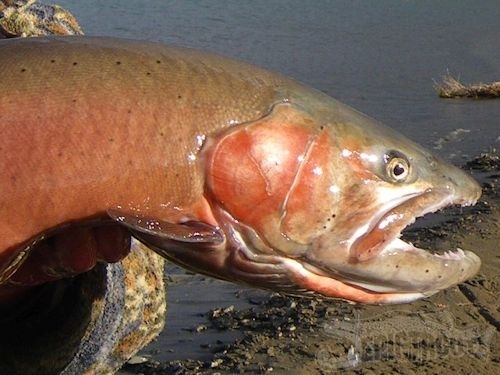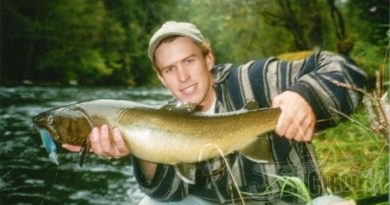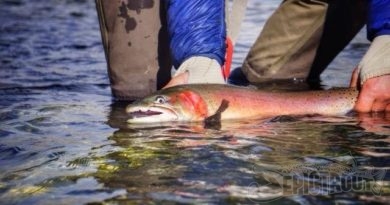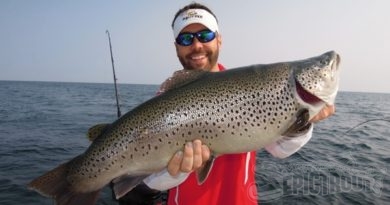Rare and Elusive Trout
There is really nothing wrong with catching stub tailed hatchery rainbow, brown, and brook trout. It’s provided countless hours of enjoyment for me throughout my fishing career. Catching the big three of the trout world also gave me the skills needed to catch some of the more aberrant species. My matriculation on the Truckee River involved catching hundreds of gullible rainbows on nightcrawlers and spinners. Those skills eventually translated into catching steelhead, which also lead to catching coastal cutthroat trout. After catching hundreds and thousands of rainbows, I wanted the challenge of the wily brown trout, and I began to throw minnow plugs in the evenings. I eventually managed to fool a few respectable browns, and I began to develop a taste for things that weren’t so easily obtained. It wasn’t necessarily a desire for big fish, but perhaps it was the satisfaction of catching fish that were unobtainable for the masses of guys that
were content to soak dough baits and fill a stringer.

When I was eighteen years old, I caught my first Lahontan cutthroat from Pyramid Lake. That fish probably fueled my desire to catch unique species and subspecies of fish more than any other single fish. At some point, I began to crack open books on taxonomy and ichthyology. With a respectable income and a reliable four wheel drive vehicle, things that I heretofore never had, many of the unique species could be within my grasp. I haven’t caught every salmonid that swims, but I’ve caught more than most. I also like catching rare species and subspecies, but I don’t get overly excited about catching 8” Skull Creek Rainbows. For me, I’m not evolved enough to be anxious to catch a fish that weighs less than a pound; even if it’s extraordinarily rare. So, the purpose of this article is to highlight some rare fish that also obtain sizes that would make most fishermen impressed when admiring a specimen in hand.
Lahontan Cutthroat
This subspecies of cutthroat trout should be the first one on any cutthroat freak’s list to catch. They get bigger than any other subspecies, they fight hard, and there are some amazing fisheries for them. Pyramid Lake is hands down the best place to catch a Lahontan. If you want to chuck fluff at them with a sissy stick, there’s plenty of that to be had. If you want to drag a U-20 Flatfish behind a 4 oz sinker, that will work too. If you want to fish most of the day, get drunk at the bar and sing Karaoke, Pyramid offers that. Plus, even if you are a big trout snob that only gets aflutter for trout over 10lbs, Pyramid is one of the best places on earth for trout that tip the scales to double digits.
Of course, if you are fishing Pyramid Lake, and you aren’t from the area, you will probably be staying in the quaint little villa known as Reno, Nevada. You can do pretty much any kind of debauchery you fancy while staying here. Do you feel like blowing the family nest eggs on a sports bet? We can accommodate you here. How about getting hammered and visiting one of our many strip clubs? We’ve got you covered. I know several guys that come here on “fishing trips” just to get away from the wife and kids and drink and party.
For Lahontan’s, there’s also Heenan Lake in Alpine County, Ca. It produces some very respectable sized trout up to about 6lbs on a regular basis. Heenan is a small lake of just over 100 acres, and it is a bug based fishery. For the most part, the fly rod is the most popular tool for catching trout here. Be that as it may, I have absolutely taken the fly rod crowd to school on that lake by dragging pearl colored Needlefish just off the bottom behind a downrigger. There aren’t any baitfishes in Heenan Lake, so why the technique works is a mystery. I would reckon that it has something to do with the fact that Lahontan Cutthroat are fond of eating other fish, and you can’t teach an old dog new tricks.
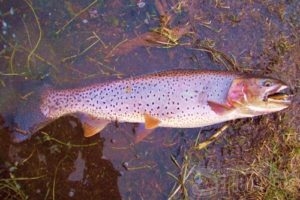
Bonneville Cutthroat
Bonneville cutthroat are the most similar cutthroat subspecies to Lahontan cutthroat. Well, maybe not evolutionarily or taxonomically speaking, as Bonneville cutthroat draw their lineage from Yellowstone cutthroat. However, this article is being written from an angler’s perspective, and the Bear Lake variety of Bonneville cutthroat are highly piscivorous; just like Lahontan cutthroat. Strawberry Reservoir is where I have all my Bonneville experience. Bonneville cutthroat were stocked there to manage the illegally introduced Utah chub. Bonneville cutthroat have a relationship with Utah chub similar to Lahontan cutthroat with Tui chub. Both cutthroat subspecies has a relationship with its prey species similar to wolves with elk or lions with zebras. In other words, they are extremely efficient predators that have evolved to kill a certain prey species over millennia. Chubs are also a very high protein food source, and they allow for trout to
obtain large size. In Strawberry Reservoir, you can expect to catch a lot of 2-4lb Bonneville’s. They can reach weights of 10lbs, but a fish like that would be rare indeed.
While fishing Strawberry Reservoir, your home base should be beautiful Heber City, Utah. Heber sits in a quiet little emerald valley tucked into the Wasatch Mountains. There are probably as many cattle living in the valley as people. It’s one of the prettiest places I’ve visited. It has a nice small town atmosphere. You probably won’t see guys with face tattoos and questionable piercings loitering about town. Nor will you find graffiti or litter. It’s like stepping back into Mayberry. There are also plenty of hotels, restaurants, and even a fly shop.
Although I’ve never fished Bear Lake, it is the mother lode for native Bear Lake Bonneville cutthroat. The Bear Lake race is the one that obtains large sizes. Other races of Bonneville’s do not grow large. Bear Lake has native populations of ciscoes and whitefish along with chubs. These prey fish allow the cutthroat to grow very large. A friend of mine recently moved to this region and fishes the lake regularly. Not only does he catch a lot of big non native mackinaw from Bear Lake, but he also catches a lot of 6-7lb Bonneville Cutthroat. The key is to imitate the forage fish the trout are eating.
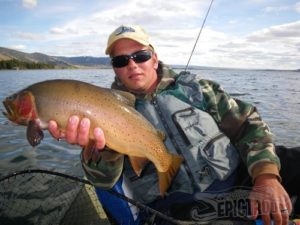
Yellowstone Cutthroat
Probably the best shot at a big Yellowstone cutthroat is at Henry’s Lake in Idaho. Henry’s is an awesome fishery when it’s at its best. Yellowstone’s are not big fish eaters. They make their living eating invertebrates for the most part. That’s not usually a good recipe for large trout, but at this shallow lake, the bugs are extremely prolific. There are gazillions of scuds, and that is what drives the fishery. Scuds are tiny crustaceans that prosper in shallow weedy lakes. Henry’s is only about 20’ deep at its deepest point, and the bulk of the lake is much shallower. The water is fairly clear, and the dense weed beds grow throughout the lake. From the description above, you can probably deduce that Henry’s isn’t great for trolling with deep water trolling tactics. When I fished Henry’s several years ago, I wasn’t privy to the knowledge of how deadly a marabou jig is. Instead, I tossed wooly buggers on a 6wt fly rod. It
was very effective, and I caught a lot of fish, but I can’t help but think I left a few fish on the table by not having jigs in my arsenal. I would love to go back and destroy them with a 1/8th ounce brown marabou jig. Not only are there Yellowstone Cutts’ that get to 6lbs in this lake, but there are also hybrid rainbow/cutthroats that go over double digits. I was totally owned by a big cutbow on my trip up there. I’ll never forget when I stripped my fly into the mouth of a brick wall. Then the brick wall started moving, and then the brick wall ran me into a weed bed and broke me off. It was a monster fish. I still have nightmares in slow motion about losing that beast.
The main hub for Yellowstone Cutthroat is Island Park, Idaho. It’s a little fancy and high society for my taste. It’s a beautiful little town, but things are on the expensive side. The Trout Hunter Bar and Restaurant is a must stop location while there. They have great food and you will see the who’s who of Island Park fishing guides on their R&R time. There is also plenty of lodging in Island Park, and just twenty miles west you will find West Yellowstone, Montana. West Yellowstone is the western entrance to Yellowstone National Park.
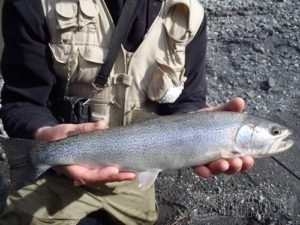
Coastal Cutthroat Trout
This may be the most elusive of all the cutthroat subspecies; especially large individuals. They have the widest range of any of the cutthroat subspecies, but anywhere they are found they play second fiddle to steelhead, Chinook and Coho. In many places they are considered nothing more than a nuisance and a bait thief. I find them to be quite cool. In California, where I fish, they are quite rare. The further north you go, they become more and more common. Anywhere you find them, not much will be known about them. It’s even hard to pinpoint how big they get. A Coastal over 20” would be a big fish, but I’ve heard stories from respected guides of fish over 5lbs, and even a story of one that was steelhead sized at 9lbs. Fact or fiction, I will leave that for you to decide. I do know for a fact that double digit Coastal cutthroat have come from Washington’s Crescent Lake on the Olympic Peninsula. I also know that Lake Washington near
Seattle has a thriving Coastal fishery. Do yourself a favor and go on YouTube and watch the episode of Angler West TV where they fish Lake Washington for Coastal cutts.
I’ve caught most of my Coastal cutts’ incidentally while fishing roe or egg imitations for steelhead. They are highly predatory fish. They play a serious role in preying on salmonid smolts as they head for the ocean. They also are known to have a love of eating sculpins. Where it’s legal, guys have been known to fillet a sculpin and dunk chunks of sculpins meat for some really big cutts’. I’ve also heard stories of big cutts’ hanging around fish cleaning stations and picking off chunks of loose salmon meat and guts when the carcasses hit the water.
Where should you fish for Coastal cutthroat? Well, they live in the same streams that steelhead live in, and steelhead streams are just like brown trout lakes. The first rule of steelhead fishing is not to talk about steelhead fishing. The second rule is not to talk about steelhead fishing. Therefore, Coastal cutthroat are guilty by association.
Coastal cutthroat also make large seasonal movements that can really stymie anglers. According to Patrick Trotter’s book, Cutthroat; Native Trout of the West, anadromous Coastal cutts have an obligatory freshwater stage during the winter months. They simply will not over winter in the ocean. However, they do not necessarily overwinter in their natal stream, and they may spend the winter months in a nearby river. Be that as it may, they rarely stray from their natal stream when it comes time to spawn. In a nutshell, anadromous Coastal cutthroat may spend anywhere from a few weeks to a few months in the ocean at any given time, and then they have a necessity to return to freshwater sometime from about September to January depending on the river drainage. Some of those fish will return to their native stream, over winter and spawn. Others will over winter in a stream that they didn’t originate in, return to the ocean to feed, or use the ocean as
a highway to their native stream for spawning purposes. No matter how you slice it, these may be the hardest fish of all to pin point and consistently catch. I love them and find them to be possibly the most fascinating of all salmonids.
Obviously, with a historical distribution from the Eel River in Northern California to Southern Alaska, there are many towns to stay in and pursue these fine fish. The closest towns to most people reading this article would likely be Crescent City, California, or Brookings, Oregon. Both are full service towns with all the accommodations one could want. Also of interest in Crescent City is a booming meth ad marijuana industry and Pelican Bay Maximum Security Prison. Make sure you lock your vehicles at night and remove the valuables to prevent some tweaker from making off with your loot. Refrain from brutally murdering somebody, and you won’t find yourself in Pelican Bay. Aside from the meth and marijuana and the super max prison, there is fantastic coastal cutthroat fishing to be had on the nearby Smith and Chetco Rivers. Often times the best cutthroat fishing comes right at the tail end of the steelhead season in late March.
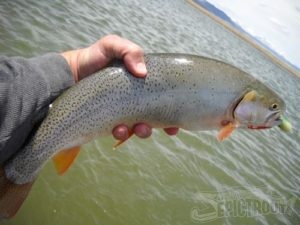
Snake River Fine Spotted Cutthroat
There is no known genetic difference between Yellowstone and Snake River cutthroat, however, take a look at them side by side with the naked eye, and you will see the difference. The Snake River Fine Spotted cutthroat is covered with, drum roll please, fine spots. Tah, dah! They are also the most commonly planted and hatchery produced of all the cutthroat subspecies. They are native to a stretch of the Snake River in Wyoming, but they have been widely established outside their native range. They are known to be more “gamey” than other subspecies of cutthroat trout, in that they behave more like a rainbow trout once hooked. That translates to the fact that they fight harder than most other cutthroats.
Aside from the Snake River in Wyoming, they can be found in many places throughout the west. My experience with them comes from Antero Reservoir on the South Platte River in Colorado. They are non native there, but they are also beautiful fish that are worthy of pursuit. They obtain sizes of 1.5-4lbs in the reservoir, but they can get much larger in the section of the South Platte below the lake. This section of river from Antero to Elevenmile Reservoir is known as the “Dream Stream,” because it is ideal for fly fishermen in that it offers huge fish and it flows mostly through a casting friendly meadow.
If you fish the Antero, Spinney, and South Platte area, your home base will be lovely Fairplay, Colorado. If you’ve ever watched the cartoon, “South Park,” this is the region where the cartoon was set. The town is proud of its legacy. You can take your picture with a painting of a human sized, Mr. Hanky, the Christmas Poop. There are very few services in Fairplay outside of hotels, gas stations, one or two bars, and a small grocery store.
Other Cutthroat
The above listed subspecies are the ones that I am familiar with. There are several others, including: Greenback, Colorado River, Rio Grande, Paiute, and Westslope. There are also a few more races that are possibly to be considered subspecies depending on the taxonomist. However, none of the above mentioned subspecies are known for obtaining sizes over about 20”, and therefore they haven’t merited a trip to a remote part of the country for me to pursue them.
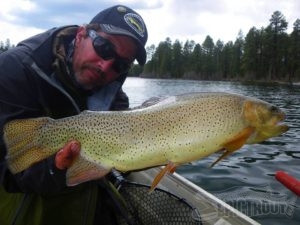
Apache Trout
Way out on an island in Arizona is the Apache trout. This fish is more closely related to rainbow trout than cutthroat trout. It likely evolved from a rainbow trout ancestor that lived in the Colorado River when it was more hospitable to salmonids. As the climate grew hotter and drier, the fish were left in the mountain refuges of eastern Arizona. Apache trout once neared extinction, but in particular, the White Mountain Apache Tribe has made huge efforts to restore them. Their efforts involved removing non native rainbow and brown trout, securing a reliable pure brood stock. Their efforts have been largely successful. At one time these fish were nearing extinction, and now they can be found in fishable numbers. Not only are there fishable populations, but they grow to larger sizes than they ever historically did. Apache trout had no lakes in their native habitat, but now there are several small reservoirs that they inhabit, and they grow to
much larger sizes than was previously possible. In particular, there are two lakes on the White Mountain Reservation, Christmas Tree and Hurricane Lake, that grow world record sized fish to 5lbs. Both of these lakes have per day rod quotas that limit the angler capacity to 25 rods per day. These are not large bodies of water, and they can’t handle a ton of fishing pressure.
The White Mountains are not jagged rocky mountains. They are more of a big ridge of Ponderosa pine covered hills. The best trout fishing in all of Arizona can definitely be found there. I would recommend staying in Pinetop, Arizona. It’s an upscale skiing based community. My wife and I made the mistake of staying in Show Low, Arizona. Maybe there was nothing wrong with Show Low, but there certainly was nothing right with the Snowy River Inn. My wife is seldom funny, but she had me laughing when she called it the “Snowy River Dump,” and the “Moldy River Inn.” It was a real “sticky sheets motel,” kind of a place. I remember the black mold festooned all over the shower walls like it was yesterday. In other words, don’t stay there, and if you do, you may want to sleep in your sleeping bag on top of the bed.
Gila trout can be found just to the east of the range of Apache trout, but Gila trout have only recently been decommissioned from endangered to threatened status, and there are relatively few fisheries. Also, they are mostly restricted to extremely small streams, and therefore they don’t grow to a size that has merited much interest from me. Although they are beautiful and precious fish, I doubt I will pursue them.
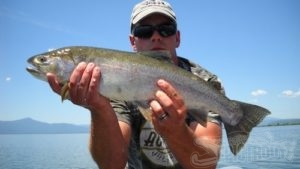
Redband Trout
Although Redband trout fall under the heading of rainbow trout, there are a few distinct races and subspecies worth mentioning. This article is being written for a trout fishing website, but the most noteworthy would be the Redband steelhead of the Upper Columbia Basin. What exactly does that translate to, you ask? Idaho’s A and B-Run steelhead fall under that classification. Of course, the B-Runs can grow to 40” plus and 25lbs. That’s certainly a fish worth noting.
The other Redband trout that is absolutely remarkable is the Klamath Lake Redband. These fish are similar to Lahontan cutthroat in that they have been able to obtain large sizes because of their highly predatory nature. Also, Klamath Lake is a huge lake that is mostly extremely shallow and full of life. It is a pea soup green stew that creeps and crawls with insects, crustaceans, and baitfish.
I have made one trip to Klamath and experienced some pretty impressive fishing landing fish in excess of 5lbs. These fish are fairly distinct looking from other rainbow trout. They tend to be a long torpedo shaped fish. They aren’t deep from pelvic to dorsal, but they seem broader across the back to me, and they have a broader head that reminds me of a Bull trout. Oh yes, Bull trout, Dolly Varden, and Arctic char, I’d love to tell you about them, but I’ve never caught one. I digress. So, I made a long trip up to Klamath Falls to fish the lake, and I had allotted for several day s of fishing, and on my first day I caught several big fish. Where’s the problem? Klamath Lake can be one of the most god awful places on earth to wet a line. Why, you ask? It is absolutely full of mosquitoes. The lake is pretty much a big flooded marsh; perfect trout as well as mosquito habitat. It didn’t matter how much bug spray I applied, they found a
way to get me. They bit my eyelids, and they bit my ass when I attended to nature’s calling. They bit the insides of my nostrils. Miserable. Plus, it was 100 degrees out and nothing short of an oven. I would love to go back and take another whack at Klamath Lake in the late fall or early spring when the bugs aren’t so bad.
Hybrids
This article is becoming a sweeping epic. It’s far too long, and I need to wrap it up, but I would be remiss if I didn’t mention some of man’s tinkering in the form of fine finfish.
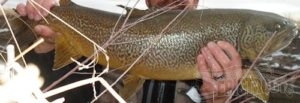
Tiger trout are some of the most amazing fish I’ve ever caught. They are truly beautiful, and they combine great characteristics of both brook trout and brown trout. They behave a lot like brown trout in that they are structure oriented fish. I routinely catch them tight to rocks, weed beds or brush. They also are highly predatory fish like brown trout, and where they grow the biggest it is usually in response to a prolific prey source. In Utah, Schofield Reservoir is known for growing some of the biggest tigers on the planet. These fish are getting fat on illegally introduced Utah chub. In Nevada, most of our Tiger trout fisheries rely on scuds. Where there are adequate food sources, Tiger trout can go over double digits, although a 3-5lber is a nice fish just about anywhere.
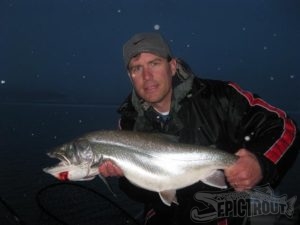
Splake are just plain cool. I envy Mark Knoch’s giant Splake from a nameless lake more than just about any other single fish. I’d love to catch that fish. Splake got all the best attributes of lake trout and all the best features of brook trout. They grow much larger than a brook trout, and they aren’t sluggish on the hook like a lake trout. When you hook a splake, it will run and possibly even jump like a rainbow. I have caught splake from Antero Reservoir in Colorado. They were great gamefish. Colorado and Utah both stock fair numbers of splake in a few fisheries.
That’s it. I’m done. I’m spent. I can’t go down the twisted path of whitefish and landlocked salmon. It’s a deep valley that there’s no coming back from.

